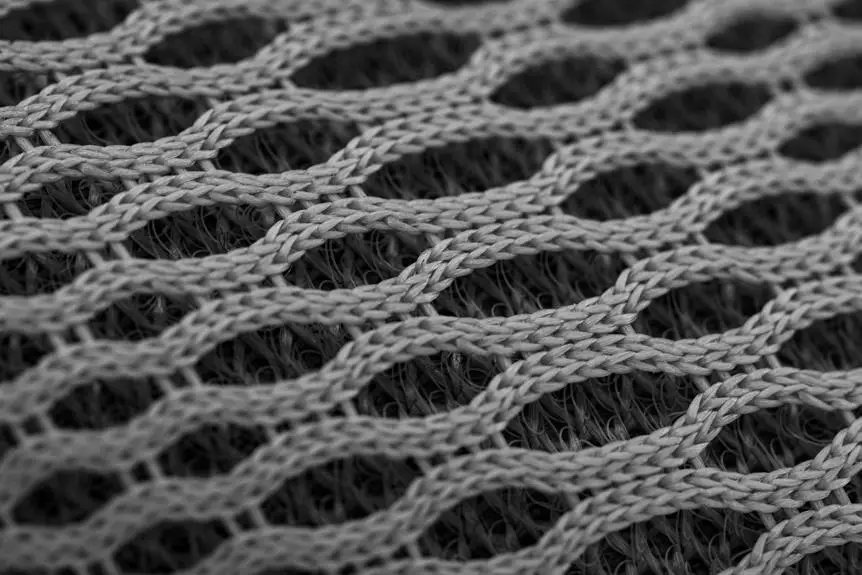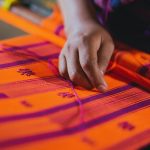When you're designing with fabric markers, the choices you make can significantly impact your final piece. It's essential to select the right markers and prepare your fabric properly to achieve the best results. You might find that a little planning goes a long way, especially when it comes to sketching your design and applying various techniques. However, there are also common pitfalls that can derail your creativity. Understanding these can save you time and frustration as you embark on your fabric art journey. What you learn next could transform your approach entirely.
Table of Contents
Key Takeaways
- Choose permanent fabric markers for vibrant colors that withstand washing and sunlight exposure.
- Pre-wash fabric to remove oils and dirt, ensuring better ink absorption and color vibrancy.
- Test markers on a scrap piece of fabric to assess color accuracy and performance before starting your design.
- Plan your design with light pencil sketches to visualize patterns and color placements for a balanced look.
Choosing the Right Fabric Markers
When picking fabric markers, consider their permanence and color vibrancy to ensure your designs stand out and last. You want markers that won't fade or wash away after a couple of uses. Look for fabric markers labeled as permanent; these typically resist washing and sunlight, keeping your artwork intact. Test a few brands to see how they perform on your chosen fabric.
Color vibrancy is equally important. Choose markers that offer a wide range of bold, bright colors. This variety allows you to create eye-catching designs that pop against the fabric. Some markers may appear vibrant on the packaging but can lose their luster once applied, so read reviews or ask for recommendations to avoid disappointment.
Additionally, consider the tip size. Fine tips are great for detailed designs, while broader tips can cover large areas quickly. You may want to invest in a set that includes both to give yourself flexibility in your projects.
Lastly, check if the markers are water-based or non-toxic, especially if you're working with kids or doing projects that'll be used frequently. Choose wisely, and you'll set yourself up for successful fabric creations!
Preparing Your Fabric Surface
Before you start your design, it's crucial to prepare your fabric surface properly.
Choose the right fabric, clean and pre-wash it to remove any dirt or sizing, and don't forget to test your markers on a scrap piece.
This way, you'll ensure your artwork looks great and lasts longer.
Choose the Right Fabric
Choosing the right fabric is essential, as it can significantly affect the outcome of your design with fabric markers. When selecting fabric, consider the texture and weight. Smooth, tightly woven fabrics like cotton or canvas are ideal, as they allow for even application and vibrant colors. Avoid slippery or loosely woven materials, as they can cause your designs to bleed or appear uneven.
Next, think about the fabric's color. Light-colored fabrics typically work best, since they provide a blank canvas that makes your colors pop. Dark fabrics can be used, but you'll need to choose opaque markers or lighter colors to ensure visibility.
Also, consider the fabric's intended use. If your project is meant for clothing or items that will be washed frequently, opt for durable fabrics that can withstand regular wear and tear. Fabrics that have been treated with finishes may not absorb ink well, so always check the label.
Clean and Pre-Wash
To ensure your designs turn out as vibrant as possible, clean and pre-wash your fabric to remove any dirt, oils, or finishes that could interfere with the ink's absorption. This step is crucial for achieving the best results with your fabric markers.
Here's a quick guide to help you through the cleaning and pre-washing process:
| Step | Description | Tips |
|---|---|---|
| 1. Select Detergent | Use a mild detergent to clean your fabric. | Avoid harsh chemicals. |
| 2. Wash Fabric | Machine wash or hand wash the fabric in warm water. | Check care labels. |
| 3. Dry Fabric | Air dry or tumble dry on low heat after washing. | Iron if needed. |
Once your fabric is clean and dry, you'll have a smooth canvas ready for your artistic expression. Remember, skipping this step could lead to dull colors or uneven ink application, so take the time to prepare properly. Enjoy the process and let your creativity shine!
Test Your Markers
Testing your markers on a scrap piece of fabric ensures they'll deliver the colors and precision you want for your design. Grab some similar fabric to what you'll be using for your project and start experimenting. This quick test not only shows how the colors appear but also how they interact with the fabric's texture.
Apply the markers as you normally would, taking note of how they flow and whether they bleed or smudge. It's crucial to check how the colors look when dry, as they can shift during the drying process. If you notice any discrepancies, you might want to adjust your technique or choose a different marker.
Also, keep in mind that different fabric types can affect the final outcome. Cotton, for example, may absorb ink differently than polyester. Once you're satisfied with your test results, you'll feel more confident about moving forward with your design.
This step saves you time and frustration later, ensuring your project turns out just as you envisioned. So, don't skip this vital part of the process—test your markers before committing to your final piece!
Planning Your Design
When planning your design, the fabric you choose plays a crucial role in how your markers will perform.
It's smart to sketch your ideas first, so you can visualize the final look and make adjustments as needed.
This step sets the foundation for a successful and vibrant design.
Choose Your Fabric Wisely
Choosing the right fabric is crucial, as it affects how your design will look and feel once completed. Different fabrics absorb ink differently, so consider what material aligns best with your vision.
Cotton is a popular choice because it's absorbent and provides vibrant colors. If you're looking for something stretchier, jersey knit can work well but may cause your markers to bleed, so test it first.
You should also think about the fabric's texture. Smooth surfaces, like canvas or poplin, let your designs pop, while textured fabrics may diffuse the ink, making your details less sharp. Pay attention to the fabric's weight; heavier fabrics like denim require more pressure during application, which can affect your control.
Don't forget to check the fabric's care instructions. If your piece needs to be washed regularly, ensure it's compatible with fabric markers that are designed for durability.
Lastly, consider the project's purpose—decorative pieces can use a wider range of fabrics, while wearable items should prioritize comfort and durability. Choosing wisely will set the stage for a successful and enjoyable design experience.
Sketch Your Ideas First
Before you dive into coloring your fabric, take a moment to sketch your ideas, as this will help you visualize your design and make adjustments before committing to the final piece. Sketching not only clarifies your vision but also allows for experimentation with different layouts and colors.
Here are some tips to consider while sketching your ideas:
- Use light pencil strokes: This way, you can easily erase and modify your design.
- Incorporate patterns: Experiment with various patterns to see what complements your main design.
- Think about color placement: Visualize where each color will go to balance the overall look.
- Consider the fabric's texture: Some designs may look different on various fabric types.
Techniques for Application
Experimenting with different techniques can elevate your fabric marker designs and create stunning results.
Start by trying out various strokes—lines, dots, and swirls—to see how they interact with the fabric. You can achieve different effects by adjusting pressure and speed; lighter strokes yield softer lines, while heavier pressure creates bolder designs.
Consider layering colors for depth. Apply one color and let it dry before adding another. This method allows for blending and creates a unique look.
Don't forget about stencils! They can provide structure and precision for more intricate designs. Just hold the stencil steady while you apply color.
Another effective technique is the use of shading. Choose a darker shade of your base color and lightly add it to one side of your design. This simple trick adds dimension and makes your artwork pop.
If you want a softer effect, try using a wet brush to blend colors together.
Setting and Caring for Your Artwork
After you've completed your design, it's essential to set the fabric markers to ensure your artwork remains vibrant and intact. Setting your artwork properly will help prevent fading or smudging, allowing you to enjoy your creation for a long time.
Here are some steps you can take to care for your fabric marker artwork:
- Heat Setting: Use an iron on the reverse side of the fabric, set to the appropriate temperature for the material, to heat set your design.
- Avoid Washing: For the first 72 hours, avoid washing the fabric to allow the ink to cure properly.
- Gentle Cycle: If washing is necessary later, use a gentle cycle in cold water to protect your design.
- Air Dry: Always air dry your fabric instead of using a dryer to prevent wear and tear on your artwork.
Troubleshooting Common Issues
Sometimes, you might encounter issues while using fabric markers, but many common problems have straightforward solutions. Here are a few troubleshooting tips to help you get back on track:
| Issue | Solution |
|---|---|
| Faded colors | Use fabric markers with a higher pigment concentration. Apply multiple layers for vibrancy. |
| Colors bleeding together | Ensure the fabric is dry before applying more colors. Use a heat setting to prevent bleeding. |
| Markers not flowing well | Shake the marker gently or store it upright for a few hours to allow the ink to settle. |
| Stains from fabric markers | Rinse the area with cold water immediately. For stubborn stains, use a mild detergent. |
| Designs cracking after washing | Use a fabric medium or heat set the design to ensure durability during washes. |
Frequently Asked Questions
Can I Mix Different Brands of Fabric Markers?
Yes, you can mix different brands of fabric markers. Just ensure they're compatible in terms of ink type and application. Test them on a small area first to see how they interact with each other.
How Long Do Fabric Markers Typically Last?
Fabric markers typically last for several months to a few years, depending on usage and storage. If you store them properly and use them regularly, you can maximize their lifespan and keep them in good condition.
Are Fabric Markers Safe for Children's Clothing?
Yes, fabric markers are generally safe for children's clothing, especially when they're non-toxic and labeled as washable. Just make sure to follow the manufacturer's guidelines and allow the designs to dry completely before wearing.
Can I Use Fabric Markers on Leather?
You can use fabric markers on leather, but results may vary. Make sure to test on a small area first to ensure the color adheres well and doesn't damage the material.
What Types of Fabrics Work Best With Fabric Markers?
When choosing fabrics for fabric markers, you'll want smooth, tightly woven materials like cotton, canvas, or polyester. These surfaces absorb ink better, ensuring vibrant colors and lasting designs that won't easily fade or smudge.
- Khadi Brand Review: Are Their Natural Products Worth Buying? - June 24, 2025
- How to Wash Khadi Clothes (Without Shrinking or Damaging Them) - June 24, 2025
- How Khadi Fabric Is Made: A Step-by-Step Look at the Hand-Weaving Process - June 24, 2025






